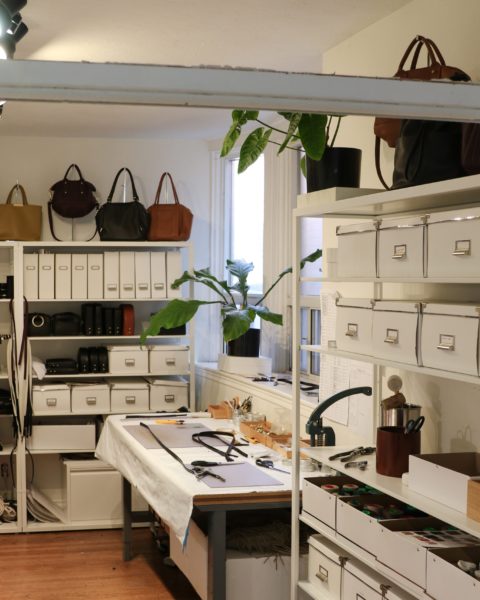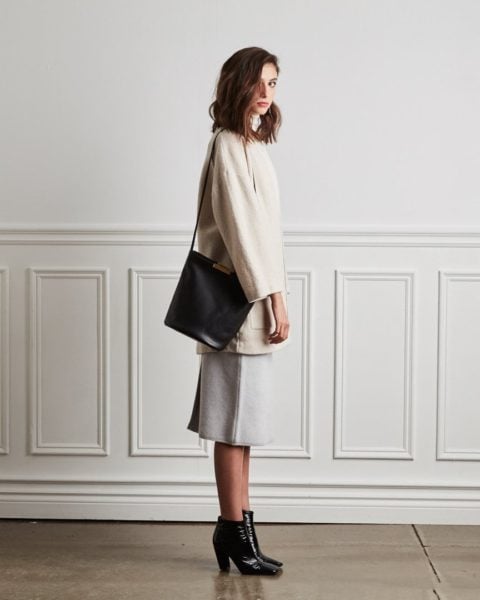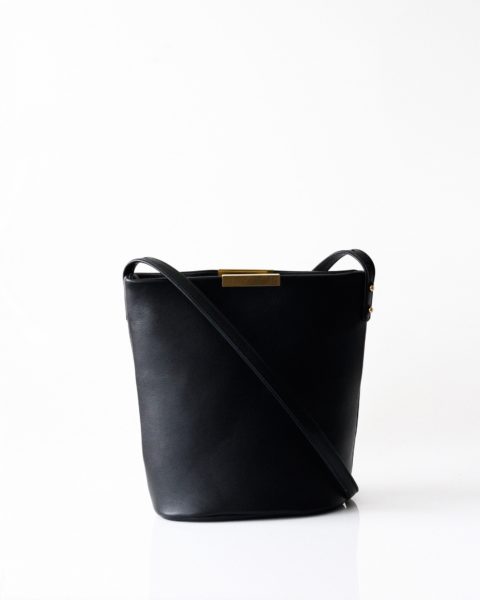Meet Opelle, The ‘Bag Rebels’ Revolutionizing the Toronto Handbag Industry
In the age of #whomademyclothes order to shift the way we think about fashion, we need greater transparency into how it’s made. In this new series, Isabel B. Slone brings you behind the scenes with the indie creators who deserve a spotlight for their sustainable, stylish practices.
~
One-hundred and twenty eight St. Clarens Avenue looks like any other duplex sitting on a leafy residential street in the west end of Toronto. The only clue that it might be something other than a single-family home is a series of black letters pasted on the mailbox spelling out ‘Opelle.’ But step inside, and you’re greeted with a half-showroom half-workshop where buttery leather handbags rest perched next to rows of quietly humming sewing machines. The earthy smell of leather wafts through the air.

Opelle, not to be confused with Swedish heavy metal band Opeth, is a high-end handbag line designed and produced Amy Malcolm and Beth Nicholson Crago in this workplace, housed on the main floor of Malcolm’s home, which she shares with her partner and two kids upstairs. From start to finish, every single Opelle bag is conceived, produced and shipped out of this small yet suspiciously well-organized work room.
“Yesterday I was walking to get my kid from school and somebody walked by, and I was like, ‘I made that bag,’” says Malcolm, the label’s founder, a diminutive blonde who exudes a sprightly, somewhat frenetic energy. “It was someone I’ve never met, and doesn’t know me from Adam. That’s so cool to me, that you can walk right past the address where something thing was made [without realizing it].”

The mystery bag-wearer can be forgiven for passing by the birthplace of their handbag unaware, because the elegance and simplicity of Opelle bags seem to transcend time and space, unlike, say, a Dior saddle bag. Their bags are made of fine grain leather – Nicholson Crago tells me that some of their leathers come from the same tannery in France that Hermes sources materials from – and the only discernable logo is a modest rectangular brass bar hammered into the opening of each bag.
Malcolm started Opelle back in 2010 for practical reasons; “I wanted one bag to do everything and I really wanted it to represent me,” she says. “I wanted to be able to get off my bike and go to an art opening, or go to dinner.” Malcolm describes her against-the-grain design philosophy as wanting to create a product line that was ethical and genuine. They keep production runs small so they can manage on their own; Opelle employs only one hired studio assistant. “We’re these bag rebels,” she laughs.

I’m visiting Opelle’s studios with the goal of learning how to make my own version of the brand’s Meena column bag. Prior to my arrival, I had assumed I would fumble through with the sewing machine under Malcolm’s direction and arrive at the other end with a wonkily-sewn bag – a Franken-Opelle – which turns out to be only semi-possible. As it turns out, leatherwork is a highly skilled task in which I’d vastly overestimated my ability to perform. Luckily for me, Malcolm and Nicholson Crago are three steps ahead and have prepared a version of the bag at each step in order to walk me through the process, like the fashion equivalent of a cooking show. I feel like a big idiot for assuming I’d be able to tackle such specialized work over the course of a couple hours, but Malcolm assures me this setup works for them – all of the partially-cobbled together handbag pieces will eventually get made into a handbag down the line.
So here’s the fine print: A Meena column bag begins with four pattern pieces: two squares for body, the bottom and the strap. The edges of the leather have to be whittled down on a skyver, a machine that shaves off the fuzzy grain bits on the back of a piece of leather to make it thinner and more pliable. It’s a machine so specialized Malcolm jokes that there’s only one 90 year man in the city who knows how to service it.

Then there’s the lining, which requires all the same pattern pieces as the leather bag and is sewn together to create a sort of soft tissue skeleton for the bag. The leather part of the bag is sewn together separately, then the two are joined and Malcolm uses an aggressive-looking tool to create the bag’s zippers by hand. Opelle leaves the edges of the straps raw rather than use the toxic paint that finishes the edges of most purse straps.
The deeper we get into the process, the more I realize that any attempt to do this on my own, even under the watchful eye of Malcolm and Nicholson Crago would have been futile. I would have ended up not with a wonky bag but a totally unrecognizable hunk of leather resembling, more or less, a pile of mashed potatoes.

After seeing firsthand the amount of work that goes into a relatively simple handmade leather bag, at $375, the Meena feels criminally underpriced.








